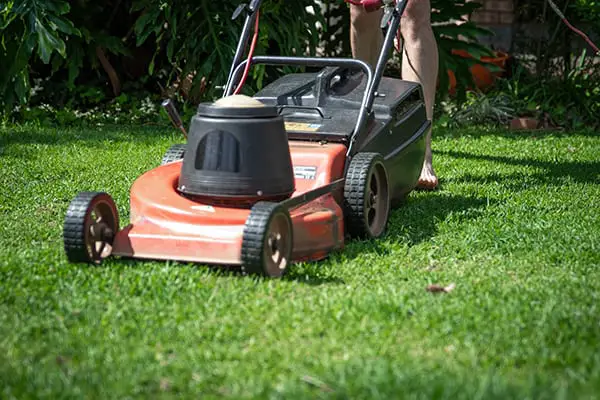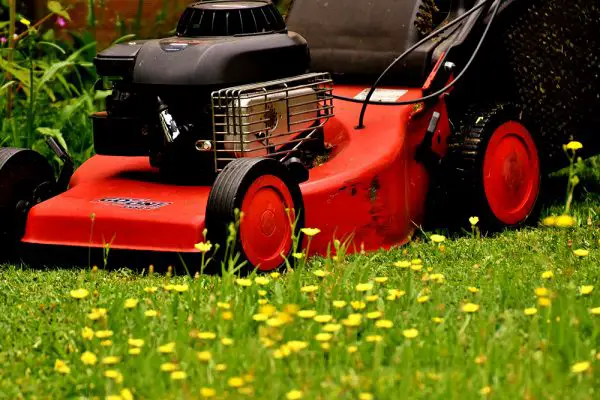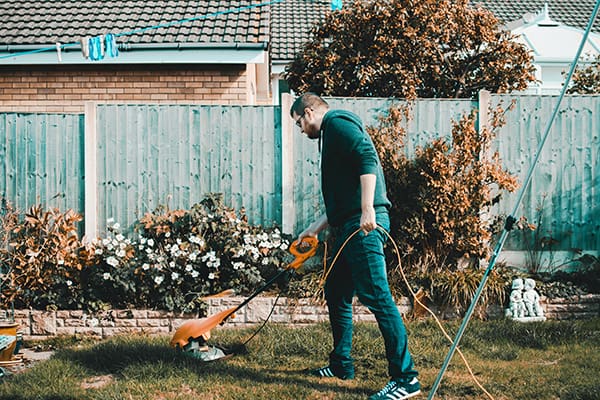There is a lot of discussion over which is the correct way to tidy your lawn, and whether or not you should mow or weedeat first. Generally, the consensus among the professionals is that you should mow the lawn first.
Some people choose to Weedeat first, but the majority of people seem to prefer to mow first. The rationale behind this order seems to be that this method allows you to clean up any areas that you missed when mowing when you Weedeat.

So a lot of people seem to believe that this allows you to get your lawn looking cleaner than if you were to do it in the opposite order.
However, the people who choose to Weedeat first believe that this is the superior method, so let’s take a look at why. Those who choose to Weedeat first seem to do it in this order as it makes your lawn look cleaner.
By mowing after you Weedeat, your mower can then collect all of the clippings from the Weedeater. This reduces the amount of dead grass left in your yard, allowing your grass to look nicer and grow healthier.
Should I mow before edging?
This is another area of lawn maintenance that is hugely debated. While some people choose to edge their lawn before they mow it, the majority of people choose to mow before moving onto the edging.
The main reason behind this is that mowing is generally a messier job than edging is. It is also a less fiddly job, and this is partly due to the machinery used to do the job.
If you do the edging before you mow the lawn, there is a good chance that you may ruin all of your hard work when you mow the lawn as it is very easy to mess up the clean edge that you worked hard on.
Whereas if you do the edging after you mow the lawn, there is no risk of you reversing your hard work as edging is a lot more targeted, so it simply makes sense to do it in this order.
If you mow first, you will also usually leave yourself with less work to do when it comes to edging the lawn as the majority of the grass will already be trimmed. Instead of having a large amount of lawn to edge, you will be left with a very small job to do.
Should I cut weeds before spraying?
In most cases, it is best to mow your lawn, and in turn cut the weeds, prior to spraying a herbicide onto it. It is not essential, but a lot of people choose to cut it first as once you apply the herbicide or pesticide, you are unable to cut your grass for at least the first few days after you apply the treatment.
If you cut the grass prematurely after applying a lawn treatment, you run the risk of the treatment not being successful as it may not have fully soaked into the grass before you trimmed it.
This is why most people choose to trim their grass first. Generally, if you are applying a pesticide or herbicide to your lawn you are doing so because you want to improve the appearance and health of your grass.
If you want to improve the appearance of your grass, the chances are that you will also want to cut it to make it look nicer. So, to avoid the risk of damaging the treatment of your lawn, we would recommend cutting your grass and the weeds before spraying treatment on it.
Is it ok to mow over weeds?
No, it is not okay to mow over weeds. While it can be tempting to do so, and it might seem like a quick way to remove the weeds from your lawn, it can actually be very damaging to your grass.
To treat weeds you have to target them specifically and tackle the problem at the roots, otherwise, you run the risk of the weeds spreading further across the lawn.
This is also the reason why you should not mow over weeds. Lawnmowers are excellent for cutting grass, but they often spread these cuttings across the lawn as you continue to mow.

So, if you mow over weeds, there is a good chance that these weeds (and their seeds) will be spread across the lawn allowing them to continue to grow and spread.
So while mowing over weeds might seem like a quick way to solve the problem, you are actually causing yourself a much larger problem by doing this.
Seeds can spread as far as 5-10 feet from the area where the weeds once were, so this will make your weed situation much worse than before.
When should you not cut your grass?
While mowing your lawn might always seem like a good idea, there are some times when you shouldn’t cut your grass. In particular, you should never cut your grass when it is newly planted and still beginning to grow.
New grass is considerably weaker than aged grass, and so if you mow it too soon you can cause irreversible damage to the lawn.
While it might be tempting to mow your lawn as soon as you notice that the grass is starting to grow, you should never cut your grass if it is shorter than 3 inches in length.
When your new grass is shorter than this it is incredibly weak and prone to damage, so if you mow it at this length you risk pulling all of the grass up, leaving bald patches in your lawn.
After it passes 3 inches in length, the new grass begins to become very strong and able to withstand the mowing without damage.
As well as avoiding cutting new grass, it is also best to only trim your grass if it exceeds 3 inches in length at any time as this could cause unnecessary damage to your lawn.
What is the earliest time I can mow my lawn?
If you want to mow your lawn, it can be tempting to do it as soon as you awake in the morning. However, before you start up the machine it is best to stop for a second and think about your neighbors.
Lawnmowers are noisy machines, so it is best to be considerate of those around you if you don’t want any animosity between you and those around you.
On a weekday, the earliest time that you should mow your lawn is 8 am on a weekday, and 9 am on a weekend. By this time most of your neighbors will already be awake and so you are less likely to upset them by using a noisy lawnmower.

But this isn’t the only reason that you should wait until later in the morning to start mowing. In the mornings, your grass will be wet with dew which can make it difficult for the lawnmower to do its job successfully.
By waiting until 8 or 9 am to mow the lawn, this not only gives your neighbors time to wake up but also allows your grass to dry before you begin cutting it, which reduces the risk of damage to your grass.
How often should you edge your lawn?
Edging is quite a fiddly job, and so it is a good thing that you do not have to do it that often. If you wish to, you can edge your lawn more regularly, but most people choose to edge their grass just once a year.
However, for this one time to be successful, it is very important that you edge the lawn at the right time of the year to get the best results. The general consensus among professionals is that you should edge your lawn sometime around the end of June.
By doing it at this time of year, you are avoiding the peak growing season which occurs between April and May, ensuring that your hard work will stay good for longer.
From July through to December, your grass really does not grow that much, and so the fiddly job of edging will look good for longer.
Whereas if you were to edge the lawn in March, the work would be quickly reversed during the growing season. So you should edge your lawn only once a year, and it is best to do this at the end of June.
